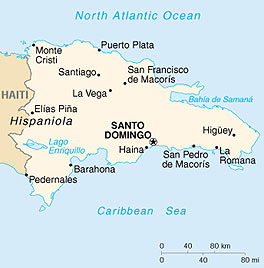The Presbyterian Church (U.S.A) shares a uniquely ecumenical witness to the gospel in the Dominican Republic, joining other North American Protestant churches in ministry there. Congregations of the PC(USA) and Dominican congregations build relationships with each other on their shared faith, mutuality and respect, and commitment to learn from one another. Because of the proximity of the Dominican Republic to the United States, Dominican Christians work with many Presbyterian mission groups each year.
The PC(USA) has a long and continuing history of participation with Dominican Christians in their ministries of evangelism, health education and care, development of water sources, academic education and outreach to Haitian immigrants.
A brief history
The island of Hispaniola, of which the Dominican Republic forms the eastern two-thirds and Haiti the remainder, was originally occupied by the Taino tribe, a branch of Arawak people. The people welcomed Columbus at the end of his first voyage in 1492. Colonial conditions reduced the Taino population from an estimated one million to about 500 in only 50 years. With the indigenous population decimated, the Spanish began bringing African slaves to the island in 1503.
French settlers occupied the western end of the island, which Spain had ceded to France in 1697, becoming in 1804 the Republic of Haiti. The Haitians conquered the whole island in 1822 and controlled it until 1844, when forces led by Juan Pablo Duarte pushed them out and established the Dominican Republic as an independent state. In 1861 Dominicans voluntarily returned to the Spanish Empire; in 1865, independence was restored. The United States occupied the area from 1916 until 1924, when there was a democratically elected Dominican government.
In 1930 Rafael L. Trujillo, commander of the army, took power and achieved absolute political control. Mismanagement and corruption resulted in major economic problems. In August 1960 the Organization of American States (OAS) imposed diplomatic sanctions against the Dominican Republic as a result of Trujillo’s complicity in an attempt to assassinate President Romulo Getancurt of Venezuela. These sanctions remained in force after Trujillo’s death by assassination in May 1961. In January 1962 a council of state was formed. In September 1963 the freely elected president was overthrown in a military coup. Following another military coup in 1965, U.S. military forces landed on Apri1 28 to protect U.S. citizens and to evacuate U.S. and other foreign nationals. More U.S. forces arrived on April 30 to avoid a complete Communist takeover.
Free elections followed, beginning in 1966 up through 1990s, although there were some charges of fraud in 1986, 1990 and 1994. The early 1980s saw riots based on economic difficulties. In 1990 President Balaguer instituted a second set of economic reforms. After negotiating an agreement with the IMF, balancing the budget and curtailing inflation, the Dominican Republic is experiencing a period of economic stability marked by low inflation, a balance of payments surplus and a leap in GDP.

